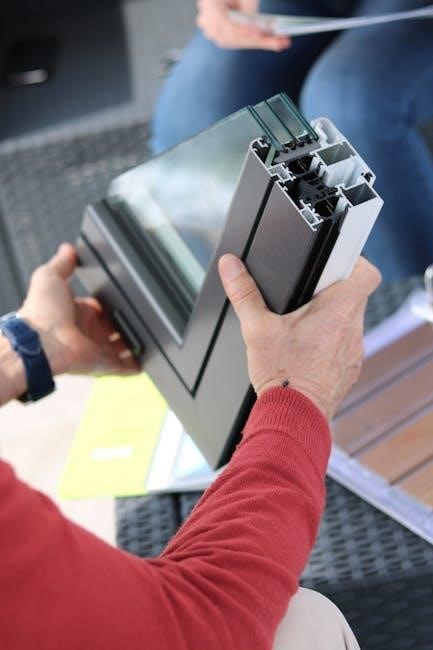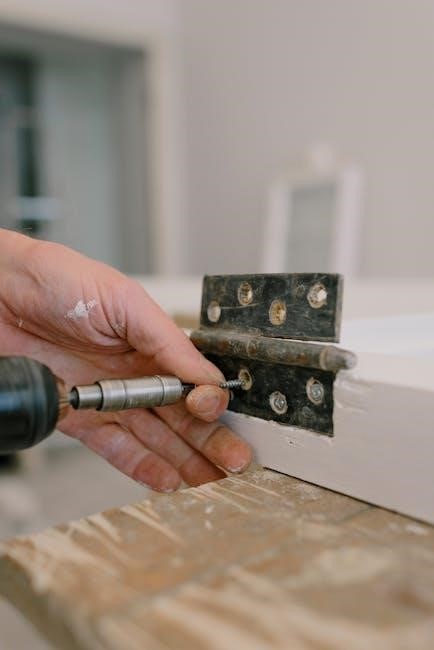This manual provides comprehensive guidance for installing the PowerFlex 753 drive, ensuring optimal performance and safety. Follow instructions carefully for proper setup and operation.
1.1 Overview of PowerFlex 753 Drive
The PowerFlex 753 is a high-performance AC drive designed for variable-speed motor control, offering advanced features like embedded I/O and TotalForce control. It supports a wide range of applications, from industrial machinery to complex automation systems. With power ranges from 0.75 to 250 kW, it ensures flexibility and scalability. The drive integrates seamlessly with EtherNet/IP and other networks, enabling efficient communication. Its compact design and user-friendly interface make it ideal for modern industrial needs, providing reliable operation and enhanced productivity.
1.2 Importance of Proper Installation
Proper installation of the PowerFlex 753 drive is critical for ensuring safety, performance, and reliability. Incorrect installation can lead to electrical hazards, mechanical failure, or suboptimal operation. It prevents issues like vibration damage and ensures compliance with safety standards. Proper setup also guarantees efficient energy use and minimizes downtime. Adhering to the manual’s guidelines ensures the drive operates within its design parameters, maximizing productivity and extending its lifespan. Correct installation is vital for maintaining operational efficiency and avoiding costly repairs.
System Requirements and Compatibility
The PowerFlex 753 drive requires specific hardware, software, and network compatibility to ensure proper functionality. Verify system specifications and compatibility before installation to avoid operational issues.
2.1 Hardware Requirements for Installation
The PowerFlex 753 drive requires specific hardware components for installation. Ensure the system has compatible AC or DC input voltage and adequate power supply. Mounting hardware must support the drive’s weight and dimensions. Proper cooling systems are essential to maintain optimal operating temperatures. Verify all electrical connections and motor compatibility before proceeding. Use only Rockwell Automation-approved components to ensure reliability and performance. Check the drive’s technical specifications for detailed hardware requirements to guarantee a smooth installation process.
2.2 Software Compatibility and Tools Needed
The PowerFlex 753 drive requires compatible software tools for configuration and programming. Use Rockwell Automation’s DriveExplorer or ControlFLASH for parameter setup and firmware updates. Ensure your PC has compatible operating systems and necessary communication drivers. Additional tools include a USB-to-serial adapter for RS-232 connections or an Ethernet cable for network communication. Familiarize yourself with the provided software manuals for detailed instructions. Proper software setup ensures seamless integration and optimal drive performance, while hardware tools like voltage meters aid in safe electrical connections. Verify all tools meet Rockwell Automation’s specifications for compatibility and functionality.
2.3 Network Communication Requirements
Ensure the PowerFlex 753 drive is connected to a compatible network for advanced control and monitoring. Use EtherNet/IP or DeviceNet for seamless integration with industrial automation systems. Configure network settings according to Rockwell Automation’s guidelines, ensuring proper IP addressing and communication protocols. Verify network bandwidth and latency to maintain reliable data transmission. Refer to the installation manual for specific wiring and configuration details. Proper network setup enables efficient communication between the drive and other devices, enhancing system performance and remote monitoring capabilities. Always follow Rockwell Automation’s network security recommendations for a secure connection.

Safety Guidelines and Precautions
Always disconnect power before installation or maintenance. Wear proper PPE, including gloves and safety glasses. Follow all electrical and mechanical safety guidelines outlined in the manual carefully.
3.1 General Safety Instructions
Always disconnect power before performing any installation or maintenance tasks. Ensure the drive is grounded properly to prevent electrical shock. Wear appropriate personal protective equipment, including safety glasses and insulated gloves. Follow all local and international safety standards, such as NFPA and IEC guidelines. Read the manual thoroughly before starting any work. Keep loose clothing and long hair tied back to avoid entanglement. Never touch electrical components without proper insulation or protective gear. Ensure the work area is well-ventilated and free from flammable materials. Adhere strictly to all warnings and cautions provided in the manual to ensure safe operation and compliance with safety regulations.
3.2 Personal Protective Equipment (PPE)
Wear appropriate PPE during PowerFlex 753 installation to minimize risks. This includes safety glasses with side shields, insulated gloves rated for high voltage, and a full-face shield when handling live components. Use non-conductive tools and ensure clothing is free from loose items. Steel-toe boots and anti-static wrist straps are recommended for added protection. Always follow industry standards for PPE, such as those outlined in NFPA 70E and IEC 60900, to ensure compliance and personal safety during electrical work. Proper PPE is essential for preventing injuries and ensuring a safe working environment.
3.3 Electrical Safety Measures
Adhere to strict electrical safety measures when working with the PowerFlex 753. Ensure all power sources are disconnected before starting installation. Verify voltage levels using a multimeter and lockout/tagout systems to prevent accidental energization. Ground wires must be securely connected to reduce shock risks. Avoid overloading circuits and use appropriate insulation for all connections. Follow NFPA 70E guidelines for arc flash protection and maintain a safe working distance from live components. Proper safety practices minimize electrical hazards and protect personnel from potential dangers during installation and maintenance.
Pre-Installation Checks
Before installing the PowerFlex 753, ensure the site is prepared with proper environmental conditions and necessary tools. Unpack and verify all components against the inventory list to confirm completeness and condition. Review and validate all documentation, including manuals and technical specifications, to ensure compatibility with your system. Check the motor and drive specifications for compatibility and ensure the electrical supply matches the drive’s requirements. Properly ground the equipment and verify all safety measures are in place to prevent damage or injury during installation. Conducting thorough pre-installation checks ensures a smooth and safe installation process.
4.1 Site Preparation and Environmental Considerations
Ensure the installation site is clean, dry, and free from dust or debris. The area should be well-ventilated to prevent overheating. Proper grounding is essential to avoid electrical hazards. Verify that the ambient temperature and humidity levels align with the drive’s specifications (typically 0–40°C and 5–95% non-condensing humidity). Avoid exposing the drive to direct sunlight or extreme environmental conditions. Ensure the power supply is stable and meets the drive’s voltage and frequency requirements. Proper site preparation ensures reliable operation and longevity of the PowerFlex 753 drive.
4.2 Unpacking and Inventory of Components
Carefully unpack the PowerFlex 753 drive and all included accessories. Verify the presence of the drive unit, mounting hardware, connectors, and documentation. Check each component against the packing list to ensure completeness. Handle static-sensitive components with caution, using grounding or anti-static straps. Inspect the drive for signs of shipping damage. If any damage is found, contact Rockwell Automation support immediately. Properly store all components in a clean, dry area until installation begins. Ensure all items are accounted for before proceeding.
4.3 Verification of Documentation and Manuals
Begin by cross-referencing the packing list with the shipped items to ensure all required documentation is included. Verify the presence of the PowerFlex 753 installation manual, programming guide, and reference materials. Check the firmware version listed in the documentation matches the drive’s hardware. Consult supplementary guides for advanced features like TotalForce control or network integration. Ensure all materials are up-to-date and compatible with your system. Refer to Rockwell Automation’s online resources if additional clarification is needed. Contact support if any documentation is missing or incomplete.

Physical Installation of PowerFlex 753
Ensure the drive is mounted securely, aligned properly, and placed in an environment with adequate ventilation to prevent overheating and vibration-related issues during operation.
5.1 Mounting the Drive
Proper mounting of the PowerFlex 753 drive is essential for reliable operation. Use the provided mounting hardware to secure the drive to a flat, stable surface. Ensure the drive is level and align it correctly to avoid misalignment issues. Tighten all bolts to the recommended torque specifications to prevent vibration or movement during operation. Verify that the drive is properly grounded for electrical safety. Check the environmental conditions, such as temperature and humidity, to ensure they are within the drive’s operating range. Always refer to the installation manual for specific mounting requirements and guidelines.
5.2 Ensuring Proper Ventilation and Cooling
Proper ventilation and cooling are critical for the PowerFlex 753 drive to operate efficiently and prevent overheating. Ensure the drive is installed in a well-ventilated area, away from direct sunlight and heat sources. Maintain a minimum clearance of 10 cm around the drive to allow airflow. Use fans or air conditioning systems if the ambient temperature exceeds the drive’s rated range. Avoid blocking the drive’s vents, as this can impede heat dissipation. Regularly clean dust filters to ensure optimal cooling efficiency. Refer to the manual for specific temperature and humidity guidelines to maintain reliability and longevity.
5.3 Securing the Drive to Prevent Vibration
Properly securing the PowerFlex 753 drive is essential to prevent vibration-related damage. Mount the drive on a sturdy, flat surface using the provided mounting hardware. Ensure all bolts are tightened to the torque specifications outlined in the manual. Check that the drive is level to avoid uneven stress. Regularly inspect the mounting points and re-tighten if necessary. In high-vibration environments, consider using anti-vibration mounts or reinforced brackets. This ensures stable operation, reduces wear, and extends the drive’s lifespan. Always consult the manual for specific mounting recommendations.

Wiring and Electrical Connections
Proper wiring and electrical connections are critical for safe and reliable operation of the PowerFlex 753 drive. Follow the manual’s detailed diagrams and procedures to ensure all connections are secure and meet safety standards. Verify power supply, motor, and I/O wiring before energizing the system. Use appropriate cable sizes and materials to prevent overheating and interference. Always refer to the drive’s electrical specifications for compatibility and compliance with local regulations. Double-check all connections for tightness and correctness to avoid operational issues; Adhere to lockout/tagout procedures during installation and maintenance to ensure personal safety. Grounding the drive correctly is essential to prevent electrical hazards and ensure proper functioning. Use shielded cables for sensitive signals to minimize electromagnetic interference. Label all wires clearly for easier troubleshooting and future maintenance. Ensure all connections are insulated and protected from environmental factors like moisture and dust. Consult the manual for specific torque values when tightening terminals. Avoid over-tightening, which can damage the drive’s terminals. Regularly inspect wiring and connections for signs of wear or damage. Replace any damaged cables or connectors immediately to maintain system integrity. Keep all wiring organized and secured to prevent accidental disconnections or damage during operation. Familiarize yourself with local electrical codes and standards to ensure full compliance. Use the correct tools when handling electrical components to prevent damage or injury. Test all connections with a multimeter before powering up the drive to ensure continuity and absence of short circuits. Document the wiring configuration for future reference and troubleshooting purposes. Always power down the drive before making any changes to the wiring or connections. Follow the manufacturer’s guidelines for installing surge protectors or filters if required by the application. Ensure proper ventilation around wiring to prevent heat buildup, which can degrade insulation and cause failures. Consider implementing redundant power supplies or backup systems for critical applications to minimize downtime. Train personnel involved in installation and maintenance on proper wiring practices and safety procedures. Maintain a record of all electrical connections for compliance with regulatory requirements and internal audits. Use only approved and compatible connectors and accessories to ensure reliability and performance. Protect the wiring from mechanical stress, such as bending or pinching, which can lead to premature failure. Implement a routine inspection schedule to monitor the condition of wiring and connections. Address any issues promptly to prevent potential hazards or system malfunctions. By following these guidelines, you can ensure a safe, reliable, and efficient electrical setup for your PowerFlex 753 drive. Always refer to the official Rockwell Automation documentation for the most accurate and up-to-date information.
6.1 Power Supply Connections
Connect the power supply to the PowerFlex 753 drive according to the manual’s specifications. Ensure the voltage and current ratings match the drive’s requirements. Properly ground the drive to prevent electrical hazards and ensure reliable operation. Use appropriate cable sizes to avoid overheating and voltage drop. Verify the power supply connections are secure and meet local electrical codes. Follow the manufacturer’s guidelines for installing surge protectors or filters if necessary. Always refer to the official Rockwell Automation documentation for detailed instructions and safety precautions to ensure a safe and efficient setup.
6.2 Motor Wiring and Connection Types
Properly wire the motor to the PowerFlex 753 drive using the correct cable type and size to ensure reliable operation. Follow the manufacturer’s guidelines for motor connection types, such as V/Hz or vector control. Verify the motor wiring matches the drive’s output specifications. Use shielded cables for long runs to minimize noise interference. Ensure all connections are secure and meet local electrical standards. Refer to the manual for detailed wiring diagrams and step-by-step instructions. Proper grounding and shielding are essential for safe and efficient motor operation. Always double-check connections before powering up the system.
6.3 I/O and Control Wiring
Properly connect I/O and control wiring to ensure seamless communication between the PowerFlex 753 drive and external devices. Use shielded cables for I/O connections to minimize electromagnetic noise. Assign digital inputs and outputs according to the drive’s configuration parameters. Ensure all control signals are correctly routed and terminated. Verify wiring against the drive’s terminal layout diagrams in the manual. Use appropriate connectors and follow torque specifications for terminal screws. Double-check all connections before powering up the drive to avoid errors; Proper I/O wiring ensures reliable operation and precise control of the motor system. Always refer to the manual for specific wiring guidelines. Ensure compliance with local electrical standards for safety. Use surge protectors if necessary to safeguard against voltage spikes. Test the I/O configuration after wiring to confirm proper functionality. Secure all cables to prevent vibration or movement damage. Follow best practices for cable management to maintain a clean and organized installation environment. Regularly inspect connections for signs of wear or damage.

Initial Setup and Configuration
Begin by powering up the drive and using DriveExplorer for initial setup. Configure basic parameters, such as motor settings and control modes. Perform initial testing to ensure proper operation.
7.1 Powering Up the Drive
Connect the power supply to the drive, ensuring all terminals are securely fastened. Verify the motor is properly wired and configured. Use DriveExplorer to initialize the drive, checking for firmware updates. Power up the drive and monitor its status through the control panel. Ensure no error codes are displayed. Test the drive in idle mode before integrating it with the motor. Refer to the manual for specific power-up sequences and safety protocols to avoid damage or malfunction. Always verify the firmware version matches the installation requirements.
7.2 Basic Parameter Setup
Configure essential drive parameters using DriveExplorer software. Set the motor nameplate data, including voltage, current, and frequency. Define the control mode (V/Hz or vector control). Assign digital inputs for start/stop and speed reference. Ensure motor and drive communication settings are synchronized. Save all configurations to prevent data loss. Validate each parameter to match the application requirements. Review the setup for accuracy before proceeding to testing. Proper configuration ensures optimal drive performance and motor control. Always refer to the manual for detailed parameter descriptions and setup guidelines.
7.3 Initial Testing and Verification
Power up the drive and monitor for any fault codes. Verify motor operation at minimum and maximum speeds. Check direction control and acceleration/deceleration rates. Ensure all digital inputs function correctly. Test communication interfaces like EtherNet/IP for connectivity. Validate parameter settings match application requirements. Run a trial operation under load to confirm performance. Record any anomalies and refer to troubleshooting guidelines if issues arise. Ensure safe operation and compliance with safety standards before full deployment. This step confirms the drive’s readiness for integration into the larger system.

Advanced Configuration and Programming
This section covers customizing drive parameters, implementing TotalForce control, and integrating with automation systems. Utilize DriveExplorer and ControlFLASH for advanced programming and configuration.
8.1 Using DriveExplorer for Configuration
DriveExplorer is a powerful tool for configuring the PowerFlex 753 drive. It allows users to set parameters, monitor performance, and troubleshoot issues. With an intuitive interface, it simplifies complex configurations. Key features include real-time monitoring, parameter editing, and firmware updates. Use it to optimize drive settings for specific applications. Ensure to save configurations before implementing changes to avoid data loss. Regularly update the software for the latest features and improvements. Proper training is recommended for maximizing its functionality effectively.
8.2 Programming Motor Control Parameters
Programming motor control parameters ensures the PowerFlex 753 drive operates efficiently with your motor. Key parameters include acceleration/deceleration times, motor speed, and torque limits. These settings must align with the motor’s specifications to prevent overheating or vibration. Use Rockwell Automation’s software tools like DriveExecutive or ControlFLASH for a guided setup. Adjustments should be made cautiously, as incorrect settings can affect performance. Always consult the installation manual for specific guidelines and recommendations tailored to your application. Proper configuration ensures reliability and optimal motor-drive interaction. Regular reviews of parameters are advised to maintain performance standards.
8.3 Setting Up Network Communication
Setting up network communication for the PowerFlex 753 drive enables integration with control systems and other devices. Use EtherNet/IP for seamless connectivity. Configure IP addresses and communication parameters using DriveExecutive or ControlFLASH. Ensure firmware is up-to-date for compatibility. Test network connections to verify data exchange. Proper setup allows real-time monitoring, control, and data sharing. Refer to the installation manual for detailed instructions and troubleshooting tips. Secure communication ensures reliable operation in industrial automation systems. Proper configuration enhances system performance and scalability.

Commissioning and Testing
Commissioning involves verifying drive functionality, motor performance, and system integration. Conduct thorough testing to ensure optimal operation, safety, and compliance with design specifications and standards.
9.1 Functional Testing of the Drive
Perform functional testing to ensure the PowerFlex 753 operates as intended. Check power-up sequences, input/output responses, and motor control functionality. Verify speed, torque, and direction accuracy. Use diagnostic tools to monitor performance and identify potential issues early. Ensure all safety features and protection mechanisms are active and functioning correctly. Review error logs and address any anomalies before proceeding to full operation. This step is crucial for validating the drive’s integration with the system and ensuring reliable performance under various conditions.
9.2 Motor Performance Verification
Verify motor performance by testing speed, torque, and direction accuracy. Ensure the motor operates smoothly across its entire range. Use diagnostic tools to monitor performance metrics and compare them with specifications. Check for any deviations in output under varying load conditions. Validate that motor control parameters, such as acceleration and deceleration rates, function as configured. Monitor for unusual vibrations or noise, which may indicate misalignment or imbalance. Address any discrepancies to ensure optimal motor performance and reliability before proceeding to full operational use;
9.3 Troubleshooting Common Issues
Identify and address common issues such as communication errors, overheat alarms, or overload faults. Check error logs for specific fault codes and refer to the manual for solutions. Ensure proper cooling and ventilation to prevent overheating. Verify motor and drive wiring for loose connections or damage. Use diagnostic tools like DriveExplorer to monitor performance and detect anomalies. Reset parameters or update firmware if necessary. Addressing issues promptly ensures reliable operation and prevents downtime. Always refer to troubleshooting guides for detailed resolution steps specific to each fault condition encountered during operation;

Maintenance and Upkeep
Regularly inspect and clean the drive to prevent dust buildup. Verify all electrical connections are secure. Schedule firmware updates for optimal performance and security. Maintain proper ventilation for cooling efficiency. Ensure compliance with Rockwell Automation’s recommended maintenance schedules to maximize uptime and system reliability.
10.1 Scheduled Maintenance Activities
Perform routine inspections every 6 months, including cleaning the drive and checking connections. Schedule annual checks of cooling systems and fan operation. Update firmware periodically to ensure security and functionality. Replace worn or damaged components promptly to prevent downtime. Consult Rockwell Automation’s maintenance guide for detailed schedules and procedures. Regular upkeep ensures optimal performance and extends the lifespan of the PowerFlex 753 drive, minimizing unexpected failures and enhancing overall system reliability.
10.2 Cleaning and Inspecting the Drive
Regularly clean the PowerFlex 753 drive to prevent dust buildup and ensure proper cooling. Use compressed air to remove debris from vents and surfaces. Inspect electrical connections for wear or corrosion, and tighten any loose terminals. Check for signs of overheating or physical damage. Verify that all components are securely fastened. Ensure firmware is up-to-date for optimal performance. These steps help maintain reliability and prevent potential operational issues. Always follow safety guidelines when handling electrical components.
10.3 Updating Firmware and Software
Regular firmware and software updates are essential for optimal performance of the PowerFlex 753 drive. Use DriveExplorer or ControlFLASH tools to update firmware, ensuring compatibility with your system. Always back up settings before updating to avoid data loss. Follow Rockwell Automation’s instructions for a smooth process. Updates enhance functionality, fix issues, and add new features. Avoid using unapproved software to maintain system integrity. Ensure power remains stable during updates to prevent corruption. Refer to the official Rockwell Automation documentation for detailed guidance on updating procedures.

Troubleshooting Common Problems
Troubleshooting the PowerFlex 753 involves identifying faults, addressing communication errors, and resolving overload issues. Use diagnostic tools like DriveExplorer or ControlFLASH to detect anomalies. Check connections, verify parameter settings, and review error logs for insights. Common issues include overheat conditions, motor misalignment, and network communication failures. Refer to Rockwell Automation’s official documentation for detailed troubleshooting guides and solutions to ensure optimal drive performance and minimize downtime. Regular maintenance and updates can prevent many issues. Always follow safety protocols when troubleshooting.
11.1 Identifying and Diagnosing Faults
Identifying faults in the PowerFlex 753 involves monitoring error codes, LED indicators, and system behavior. Use DriveExplorer or ControlFLASH to access diagnostic data and error logs. Common issues include overcurrent, overload, and communication errors. Check connections, motor alignment, and parameter settings. Review firmware revisions and update if necessary. Consult Rockwell Automation’s troubleshooting guides for specific fault codes, such as “CRC Fault Config 964.” Regularly inspecting the drive and its components can help detect potential issues early, ensuring reliable operation and minimizing downtime.
11.2 Resolving Communication Errors
Communication errors with the PowerFlex 753 often stem from incorrect network configurations or faulty connections. Verify EtherNet/IP settings and ensure all cables are securely connected. Restart the drive and check for firmware updates, as outdated versions can cause compatibility issues. Use ControlFLASH or HyperTerminal to reflash firmware if necessary. Consult Rockwell Automation’s release notes for specific guidance, such as updating to firmware revision 10.003. Additionally, ensure proper grounding and isolate noise sources to maintain stable communication. Always refer to the installation manual for detailed troubleshooting steps and solutions.
11.3 Addressing Overload and Overheat Issues
Overload and overheat issues can cause drive faults, requiring immediate attention. Check motor load to ensure it does not exceed drive capacity. Verify ambient temperature stays within specifications. Ensure proper ventilation and cooling systems are functioning. Use DriveExplorer to monitor thermal levels and adjust settings to prevent overheating. Regularly inspect and clean heat sinks. Update firmware to the latest version, such as revision 10.003, for improved thermal management. Consult the installation manual for specific overload protection and cooling guidelines to maintain optimal drive performance and prevent downtime. Always follow Rockwell Automation’s safety and troubleshooting recommendations.

Advanced Features and Capabilities
Explore advanced features like embedded I/O for enhanced control, TotalForce technology for precise motor management, and seamless integration with industrial automation systems for optimal performance and scalability.
12.1 Using Embedded I/O for Enhanced Control
Embedded I/O on the PowerFlex 753 enables advanced control capabilities, allowing direct connectivity to sensors and actuators. This feature simplifies wiring and enhances monitoring by integrating I/O functions directly into the drive. Users can configure inputs and outputs to meet specific application needs, ensuring precise control over motor operations. The embedded I/O also supports real-time data exchange, enabling faster response times and improved system performance. This capability streamlines installation and reduces the need for external I/O modules, making it ideal for complex automation systems.
12.2 Implementing TotalForce Control
TotalForce control on the PowerFlex 753 drive optimizes motor performance by precisely managing torque, speed, and position. It ensures smooth operation across various applications, from simple to high-precision tasks. The drive’s advanced algorithms adapt to load changes, minimizing wear on machinery and reducing energy consumption. This feature is particularly beneficial for applications requiring high torque accuracy, such as conveyors or pumps. By implementing TotalForce control, users achieve enhanced productivity, reduced downtime, and extended equipment lifespan, making it a key capability for demanding industrial environments.
12.3 Integrating with Other Automation Systems
The PowerFlex 753 drive seamlessly integrates with various automation systems, enhancing operational efficiency. It supports EtherNet/IP and other industrial communication protocols, enabling smooth connectivity to programmable logic controllers (PLCs) and human-machine interfaces (HMIs). This integration allows for centralized monitoring and control, facilitating real-time data exchange and synchronized system responses. Compatibility with Rockwell Automation’s software tools, such as DriveExplorer, further streamlines configuration and monitoring. By integrating the PowerFlex 753 into existing automation frameworks, users can achieve a cohesive and high-performing industrial control system.
Upon completing the installation, perform final checks to ensure all components function correctly. Verify power-up sequences, motor performance, and network connectivity for optimal operation and safety.
13.1 Reviewing the Installation Process
Reviewing the installation process ensures all steps were executed correctly. Verify site preparation, component unpacking, and proper mounting. Check electrical connections, wiring accuracy, and network setup. Confirm parameter configurations, motor performance, and safety measures. Ensure compliance with Rockwell Automation guidelines and standards. Address any discrepancies or issues identified during testing. Document the installation for future reference and maintenance. This comprehensive review guarantees optimal drive operation and minimizes potential downtime or safety risks.
13.2 Ensuring Compliance with Standards
Compliance with industry standards is crucial for safe and reliable operation. Ensure the PowerFlex 753 installation meets local and international regulations, such as electrical and safety codes. Verify adherence to Rockwell Automation’s guidelines and technical specifications. Confirm proper use of personal protective equipment and electrical safety measures. Ensure all documentation aligns with compliance requirements. Regular audits and inspections can help maintain adherence to standards, ensuring operational integrity and minimizing legal or operational risks.
